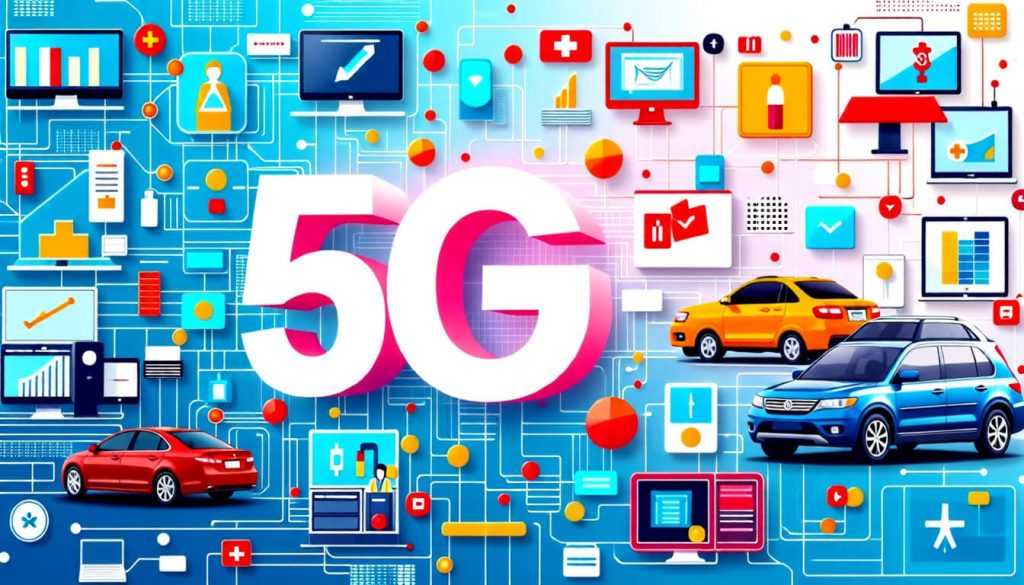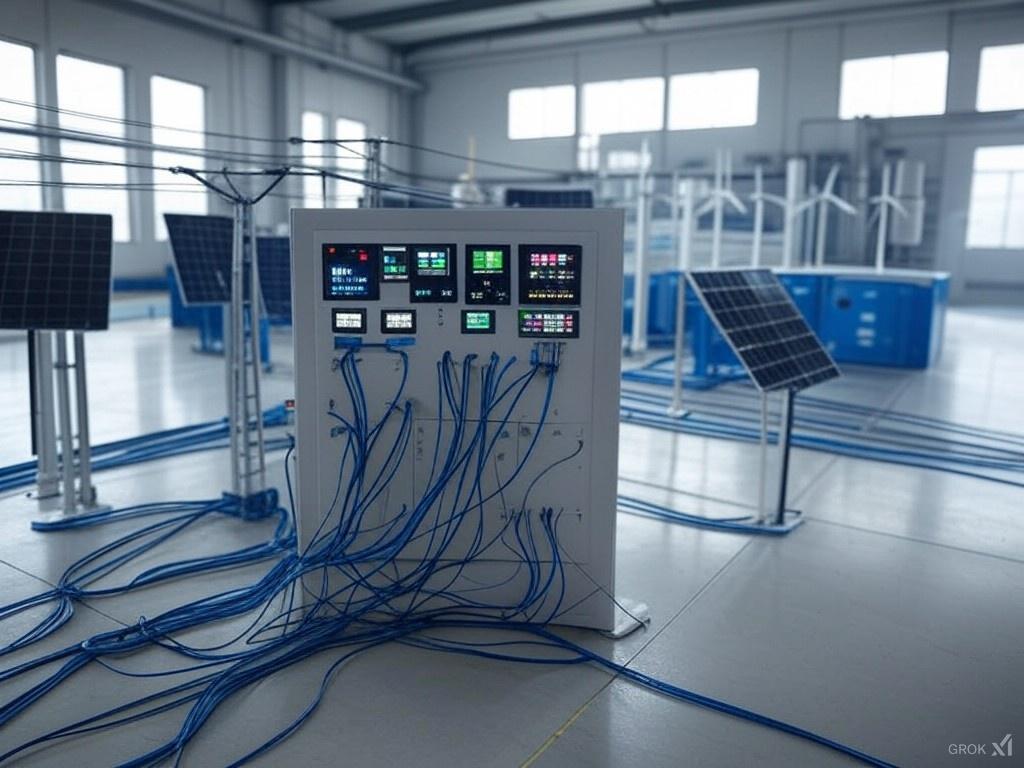Table of contents
The evolution of wireless communication has revolutionized how we live and work. The advent of 5G technology has been a game-changer, enabling seamless data transfer at unprecedented speeds and paving the way for widespread adoption across various industries.
From streaming high-definition video content to remote work, 5G’s impact on our daily lives has been remarkable. With its lightning-fast speeds and ultra-low latency, this new wireless communication standard redefines boundaries, allowing us to achieve more in a digital age where connectivity is paramount.
Understanding 5G Networks: Technical Specifications
Before diving into the technical specifications, let’s understand the architectural components of a 5G network. A well-designed network considers several key aspects, including separating the user plane from the radio access network for better management control over different cellular system parts.
This separation is crucial when building a comprehensive telecom infrastructure that operates within an optimal cost-benefit analysis. Proper handling of latency in uplinks and downlinks with accurate packet routing for all data transmissions ensures maximum network efficiency.
This process could involve utilizing software-defined networking methods to optimize transmission protocol usage inside the mobile-optimized, dynamically adaptable systems’ infrastructure. Optimized signal processing control over the entire wireless communication process flow enables seamless real-time adjustments within your system architecture for maintaining top-notch performance standards in all environments during peak or normal periods.
Establishing a robust foundation for future network adaptations and upgrades is critical before exploring technical specifications – a necessary precursor to any successful infrastructure rollout.
Key Technical Features and Advantages Explained
Even with the complexity of wireless communication, understanding 5G networks requires grasping key technical features that enhance network performance and efficiency. Surprisingly, OFDM (Orthogonal Frequency-Division Multiple Access) plays a fundamental role in modern wireless communications like LTE-Advanced and Wi-Fi 6.
By dividing the bandwidth into multiple sub-carriers, it enables efficient use of frequency resources. Dynamic TCI (Traffic Channel Allocation) is another crucial element that dynamically adjusts resource allocation to maximize network efficiency while supporting an ever-growing number of mobile devices. Impressively, MU-MIMO (Multi-User Multiple-Input Multiple-Output) technology allows multiple devices to share the same time-frequency resources by exploiting spatial multiplexing at the base station.
As we delve deeper into 5G networks, beamforming plays a vital role in enhancing network performance by adapting antenna patterns according to channel state information. This adaptive beamforming technique boosts spectral efficiency and reduces interference between nearby devices. In addition to these technical features, advanced modulation schemes like Quadrature Amplitude Modulation and Hybrid Automatic Repeat Request are key components of 5G wireless communication systems.
These technologies work seamlessly to achieve robust data transmission rates while minimizing latency. By understanding how each feature complements the other, we can appreciate the technological advancements behind modern networks that enable seamless communication between devices and minimize errors during transmission. The evolution of wireless communication has led us to this point where an intricate network of signals works harmoniously.
It is essential to note how each feature complements another, resulting in efficient data transfer rates – the essence of modern networks that rely on these features for reliable communication systems. In conclusion, 5G technology heavily relies on advanced modulation schemes and MU-MIMO techniques to provide high-speed internet services with reduced latency compared to previous wireless network standards.

System-on-Chip (SoC) Design Considerations for Improved Performance
System-on-Chip design requires careful consideration of several factors to ensure seamless communication in 5G networks. As you delve into the world of SoC, it’s essential to acknowledge the importance of power consumption, thermal management, and interface efficiency. To reduce energy consumption while maintaining data transmission speeds, designers can leverage adaptive voltage and frequency scaling techniques.
This approach not only reduces overall energy costs but also enhances performance by minimizing unnecessary computational cycles. Effective heat spreaders or built-in cooling mechanisms are crucial in high-data-rate applications like 5G networks. By preventing overheating, these strategies ensure reliable communication protocols under varying conditions.
Optimized interface design principles help minimize signal integrity issues and guarantee robust performance. This is particularly important in real-time applications where even slight variations can result in data loss or corruption. By incorporating these considerations into the SoC design process, you can develop a highly efficient chip that efficiently manages traffic flows within the network, thus guaranteeing improved overall performance of 5G networks. Remember, by carefully addressing these factors during the design phase, your System-on-Chip will be well-equipped to handle complex communication scenarios with ease.
How Industries are Leveraging 5G Technology
After analyzing the interplay between industrial automation system interoperability standards and edge computing potentialities to leverage 5G technology benefits, we can now identify areas where industries have been increasingly exploring ways to unlock new use cases by fusing IoT devices with high-speed data transmission capabilities. Here are some opportunities for industrial applications to take advantage of the transformative potential offered by 5G technology:
– Improved asset monitoring and tracking through real-time sensor data processing enabled by edge computing
– Enhanced predictive maintenance strategies resulting from correlated machine learning patterns detected in IoT-generated datasets
– Accelerated digitalization adoption, empowering industries to optimize their operational efficiency through advanced connectivity options like high-bandwidth, low-latency wireless communication systems offered by 5G networks.
Now that we’ve explored the transformative impact of Industry 4.0 on manufacturing and its potential with edge computing over 5G technology, future breakthroughs will likely rely heavily on seamless integration between these technological advancements to further optimize industrial operations. With this understanding, let’s delve deeper into exploring how industry sectors can unlock new use cases via IoT devices connected through high-speed data transmission capabilities.
Real-Time Monitoring and Predictive Maintenance
While industries find innovative ways to employ 5G technology’s benefits, real-time monitoring and predictive maintenance will be crucial aspects in leveraging its capabilities. By harnessing the ultra-low latency and high-speed data transfer rates of 5G, industrial applications can monitor equipment performance in near real-time.
This means machines will be constantly tracked for any anomalies or irregularities, allowing operators to identify potential issues before they become major problems. Additionally, predictive maintenance algorithms can analyze this sensor data along with other relevant factors like machine history, usage patterns, and environmental conditions.
By doing so, industries will experience fewer equipment failures and breakdowns due to timely interventions that prevent downtime and lost productivity. Furthermore, the vast amounts of generated data can be analyzed in real-time using edge computing capabilities for more informed decision-making processes.
For example, a manufacturing plant could use 5G-enabled sensors to continuously monitor the temperature, vibration, and other parameters of critical machinery. This real-time data can be processed at the edge, allowing predictive maintenance algorithms to identify potential issues before they occur, such as an overheating motor or a bearing nearing failure. Maintenance crews can then be dispatched to address the issue before it causes costly downtime or equipment damage.
Remote Collaboration and Enhanced Decision Making
Just as industries harnessed 5G technology to facilitate remote collaboration and informed decision-making in the past, they’re now leveraging it for seamless connection. The unique selling point of this tech lies not only in its speed but also its ability to provide a lag-free experience. This is because latency rates have been significantly reduced from what was previously known.
The underlying cause stems from 5G networks having become more efficient and adept at handling bandwidth-heavy data transfers, allowing for higher quality service with regards to jitter and packet loss – making real-time communications possible.
Compared to other technologies or norms, industries were previously limited by slower network speeds but now enjoy the ability to work remotely with greater ease and accuracy. The implications are far-reaching as this technology enables businesses to expand their reach into global markets. Remote collaboration becomes easier with reduced barriers in communication channels for all teams involved, enhancing decision-making processes across multiple levels within an organization.
For instance, a manufacturing company with facilities in multiple countries can leverage 5G technology for virtual meetings and real-time collaboration between teams. Engineers can share high-resolution 3D models and design files seamlessly, while managers can monitor production lines and make informed decisions based on live data from various locations.
As companies strive for greater connectivity and efficiency, they’ll look towards 5G networks to bridge the gap between disparate teams.

Network Architecture: Designing Efficient Networks for Seamless Connectivity
With the proliferation of Internet-of-Things devices, efficient network architecture designs have become crucial for seamless connectivity and optimal resource utilization. To optimize network resources, beamforming technology has emerged as a promising approach.
This technique involves dynamically adjusting phase shifters at each base station node to steer radio signals towards specific areas of interest. By doing so, we can effectively enhance the signal-to-noise ratio and reduce interference. Massive MIMO (Multiple-Input Multiple-Output) systems take this idea even further by leveraging a large number of antennas to create multiple beams and increase capacity per user.
This is particularly useful in scenarios where there are many users competing for limited network resources. With the ability to optimize these parameters, we can ensure that every device gets an equal share of the network’s resources.
Implementing Advanced Channel Allocation Strategies to Achieve Higher Throughput Ratios
The key challenge in wireless network architecture lies in ensuring seamless connectivity while efficiently allocating channels to achieve higher throughput ratios. As networks rely on static allocation methods, they often fall short in optimizing channel utilization, leading to bottlenecks and reduced system performance.
It’s crucial for today’s connected world that network architecture employs advanced strategies for dynamic channel allocation based on connection quality and traffic load conditions. The optimal assignment of radio resources is essential to ensure higher throughput ratios, better system capacity, and increased overall efficiency. By implementing such optimized approaches, network architects can improve the user experience while maximizing bandwidth utilization.
Enhancing Network Flexibility via Heterogeneous Small Cell Deployments
Network architecture flexibility heavily relies on optimizing interactions and adaptability between small cells. It’s an intricate process we’re trying to choreograph. Let’s dive deeper into this concept by examining the key challenges traditional large cell networks face regarding scalability and responsiveness. How do these limitations impact overall network performance during high-traffic scenarios or emergency responses?
The limitations are a significant hurdle that can make or break flexibility. To tackle heterogeneity’s negative effects on flexibility, I propose designing a framework that integrates multiple small cells into one cohesive unit. This involves developing adaptive interfaces to enable seamless communication between different frequency bands and technologies.
By doing so, we can create an ecosystem where the strengths of each technology are leveraged while its weaknesses are mitigated through strategic deployments of various radio access technologies. As heterogeneity’s flexibility limitations continue to plague network architecture, it becomes increasingly clear that a holistic solution is needed.
Security Concerns: Mitigating Threats to Ensure Secure Data Transfer
To ensure your data transfer remains secure, it’s crucial to implement network functions as a service. This not only provides improved security but also simplifies management and scalability by identifying key threats and vulnerabilities in your system. Working closely with experts from various domains like networking, database administration, and security operations helps guarantee every layer is adequately secured.
By understanding how network functions as a service works under the hood and integrating those insights into your system design decisions, you will greatly enhance overall data transfer security. The potential risks associated with inadequate threat analysis become apparent when you consider implementing network functions as a service to ensure data transfer security.
Despite the benefits, relying solely on public networks increases the risk of unauthorized access and data breaches. Network Functions as a Service (NFaaS) addresses this by separating the control plane from the forwarding plane, enabling robust access controls and improved visibility of network activity. Compared to traditional networking architectures, NFaaS’s service-oriented model offers better scalability, reduced complexity, and the ability to accommodate varying security requirements within the same architecture.
NFaaS can also coexist seamlessly with existing networks, allowing a gradual migration without disrupting operations. As the increased reliance on cloud-based infrastructure raises concerns about data integrity and confidentiality, implementing network functions as a service helps mitigate threats by providing robust access controls and improved visibility of network activity.
Leveraging Artificial Intelligence and Machine Learning-Based Solutions
In today’s interconnected world, security threats are a significant concern, and even top-rated antivirus software can fail if not properly updated. Moreover, most users may lack the expertise or knowledge to recognize and address potential vulnerabilities on their own. However, with rapid advancements in artificial intelligence and machine learning-based solutions, we’re now better equipped to tackle these security threats head-on.
These AI-powered systems utilize vast amounts of data analytics to identify patterns in malicious code, thereby improving detection rates significantly. To ensure secure data transmission, it’s crucial to take a proactive approach by continuously monitoring and assessing potential security risks. This vigilant methodology can help prevent threats from arising by detecting suspicious activity early on.
For instance, machine learning algorithms trained on vast malware datasets can quickly recognize new patterns in malicious code, allowing for swift updates to be sent out to users’ systems. Similarly, AI-driven threat intelligence feeds can analyze emerging threats and provide actionable insights for security professionals to defend against these threats effectively. By leveraging AI-powered solutions, data transmission remains secure as it passes through networks with minimized risk of breaches or exploitation.
The importance of proactive cybersecurity measures highlights the role of machine learning in detecting and preventing advanced persistent threats.
Utilizing Edge Computing and IoT Devices for Enhanced Data Protection
With the rise of IoT devices and edge computing, security concerns have shifted towards protecting sensitive data from being transferred or accessed through these new avenues. As it stands, proximity to user-sensitive data creates a unique threat vector. Attackers can exploit vulnerabilities in firmware updates or tamper with data packets before they reach the cloud.
Moreover, IoT devices’ lack of centralized control and limited communication protocols make them susceptible to brute-force attacks.To mitigate threats on both fronts, it’s crucial to implement robust encryption mechanisms at all edges within an edge computing architecture. This includes utilizing secure communication channels between devices and servers, as well as encrypting data packets before transmission.
IoT devices must also be equipped with strong security features like secure boot processes, firmware updates over-the-air (OTA), and device-level authentication. Additionally, IoT device management solutions should integrate with existing enterprise networks to ensure seamless integration of newly deployed devices.
Use Cases: Transforming Industries with 5G Technology
With the advent of 5G technology, transforming industries is becoming increasingly crucial in today’s fast-paced world. As companies strive to integrate remote workflows, they can now effortlessly transform their operations into digital ecosystems that seamlessly connect people through ubiquitous networks.
This newfound ability fosters collaboration between dispersed teams worldwide. Industry leaders engage with these high-speed connections, harnessing instant communication methods to boost productivity levels across various sectors.
For example, a global consulting firm can leverage 5G technology to enable their consultants to work remotely while maintaining seamless communication and collaboration with clients and colleagues. High-resolution video conferencing, real-time document sharing, and instant messaging facilitate efficient virtual meetings, eliminating the need for frequent travel and reducing operational costs.

Enhancing IoT Connectivity for Smarter Industrial Automation Systems
Imagine that 5G technology has enabled industries across various sectors to transform and improve their operational efficiency, with industrial automation systems now more interconnected than ever before. By integrating intelligent devices equipped with sensors and actuators into traditional methods of monitoring equipment performance, which often relied on human observation or primitive algorithms, manual processes are replaced with real-time data accessibility for better decision-making.
Imagine manufacturing facilities now using advanced analytics to optimize production line configurations based on historical trends and seasonal fluctuations in demand patterns. With enhanced predictability comes effective inventory management, resulting in reduced supply chain risks through better visibility and more precise scheduling of material deliveries.
Moreover, once industrial automation systems have streamlined communication pathways between equipment components within traditional monitoring methods, an advanced surveillance system can identify areas where bottlenecks occur due to inefficient workflows or inadequate resource utilization. The optimized performance resulting from improved coordination enables more precise monitoring and maintenance scheduling for the overall plant operation.
Imagine such an optimal state of industrial automation systems has streamlined communication pathways between components, identifying areas where inefficiencies occurred. Here’s how Industry 4.0 technology can seamlessly integrate with industrial automation systems to facilitate real-time data accessibility in manufacturing processes:
Facilitating Real-Time Data Exchange for Precise Decision Making in Industries
Through careful analysis and consideration of the transformative power of 5G technology, it becomes evident that industries can leverage this advancement not only to facilitate improved communication but also to enhance decision-making processes with precision.
The sheer speed and reliability offered by 5G connectivity enables swift information transfer between teams, departments, or even entire organizations. Decision-makers can now access timely insights from anywhere within the organization, fostering collaboration and collective wisdom. The rapid transmission of accurate data eliminates any latency that could hinder informed decision-making.
This technology facilitates streamlined communication channels for all stakeholders involved in decision-making scenarios. Users gain increased visibility into business operations through advanced analytics capabilities supported by 5G’s high-bandwidth capacity.
The Future of Wireless Communication and Its Impact on Industries
The future of wireless communication has arrived, and its impact on industries will be transformative. As we continue pushing the boundaries of what’s possible with 5G technology, it’s essential to recognize that this revolution is not just about speed but also about latency reduction, network slicing capabilities, and other innovative features.
The true potential of 5G lies in empowering industries across sectors – from healthcare to finance – by providing the foundation for seamless connectivity. For example, in healthcare, 5G could enable real-time remote monitoring of patients, allowing doctors to make faster, more informed decisions and potentially saving lives. In the automotive industry, 5G could facilitate vehicle-to-vehicle and vehicle-to-infrastructure communication, paving the way for safer autonomous driving.
As adoption increases, we can expect to see more groundbreaking use cases emerge, leveraging the unique capabilities of 5G networks. Augmented and virtual reality applications could become more mainstream, enabling immersive remote training and collaboration experiences. Smart cities could rely on 5G-powered IoT devices for efficient management of utilities, traffic, and public services.
However, realizing the full potential of 5G requires a concerted effort from various stakeholders, including network providers, device manufacturers, and regulatory bodies. Addressing challenges such as infrastructure deployment, spectrum allocation, and security concerns will be crucial for widespread adoption.
As we stand at the precipice of this technological revolution, it’s essential to embrace the transformative power of 5G while addressing its challenges head-on. The future of wireless communication promises to reshape industries, drive innovation, and unlock new possibilities that could fundamentally change how we live, work, and interact with the world around us.










